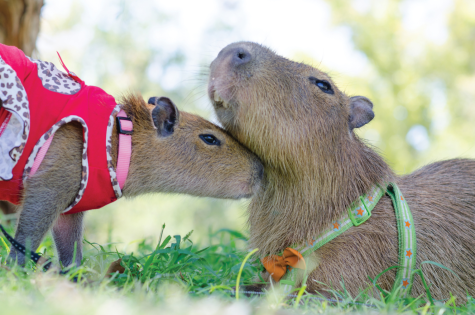Rodents At Risk

Courtesy of Pinterest
March 29, 2023
Capybaras are short-haired brownish rodents with blunt snouts, short legs, small ears, and almost no tail. These rodents are native to South America. They are the largest living rodent and a member of the Genus Hydrochoerus. They are mostly shy yet very friendly and social. Some may know capybaras from the memes on social media. Despite how friendly these rodents are to other animals, and even humans, they can be a risk of decreasing population-wise.
A major reason as to why the capybara population is in danger is because they are always being hunted by predators, even humans. Capybaras are naturally threatened by jaguars, caimans and anacondas, and their young can be taken by ocelots and harpy eagles. Around 7,000-8,000 capybaras are being hunted per year. The current population of Capybaras is one half million, which is considered not to be that many for an animal like this. The main reason capybaras are being hunted is extensively for their meat and their hide, which can be used to make leather.
However, while not many people know about or put this animal to mind, some people who do have knowledge on these rodents are coming together to help protect capybaras. Capybaras depend on healthy aquatic ecosystems to survive. Places like zoos and other industries are encouraging visitors to conserve water and protect aquatic habitats, which can provide assistance to the protection of the capybara and other species that require a similar habitat. But how can you help at home? Believe it or not, in most states in the US, it is legal to own a capybara as a pet! Yes, capybaras can indeed be house pets or domesticated! A capybara can be trained and when trained properly, can live in a home with other companion animals, like dogs and cats. People have reported that they make very nice pets.
“I like Capybaras because they are one of a kind of species that you wouldn’t see anywhere else. I would help save the endangered population by making it a law that if you are caught trying to harm/kill a capybara, you are sentenced to ten years in jail. I would also make it law that whenever a hunter goes hunting they are instructed to record what they are hunting down and send it to the authorities for proof that they aren’t hunting capybaras. Also to help save the population I would make it illegal to cut down any population’s habitat, and make it so they can live a more comfortable life,” according to 7th grade student Asher Bernard.

Giving a capybara a comfy home can make them feel safe and protected, keeping it socialized with other companions can also help too. If you’re deciding to keep a capybara as a pet, you should consider its favorite foods. One of its top favorites is watermelon, and since they are herbivores they eat a diet of aquatic plants, grasses, barks, tubers, and sugar cane. Another cool fact to know about capybaras is that they are fantastic swimmers. If you would like to adopt a capybara, you should take it to a pool where they are allowed to swim. You would be shocked! They swim with only their nostrils, eyes, and ears above the surface. This is what a capybara is known for, to be very proficient swimmers, and to be the best companion.










































